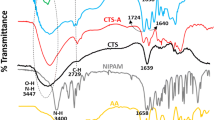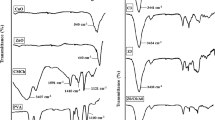Abstract
In the present study, β-cyclodextrin-grafted chitosan nanoparticles (β-CD-g-CS NPs) were prepared using a new ionic gelation strategy involving a synergistic effect of NaCl (150 mmol/L), 4-(2-hydroxyethyl)-1-piperazineethanesulfonic acid (HEPES, 10 mmol/L), and water bath sonication. This new strategy afforded smaller and more monodisperse β-CD-g-CS NPs vs. the classical ionic gelation method. New HA/β-CD-g-CS NPs were also prepared using the above-mentioned strategy by adding hyaluronic acid (HA) to the β-CD-g-CS copolymer at different weight ratios until the ZP values conversion. The best result was obtained with the weight ratio of w(HA):w(β-CD-g-CS) = 2:1 and furnished new spherical and smooth HA/β-CD-g-CS NPs. Furthermore, the stability of β- CD-g-CS NPs and HA/β-CD-g-CS NPs at 4°C in physiological medium (pH 7.4) was compared for 3 weeks period and showed that HA/β-CD-g-CS NPs were more stable all maintaining their monodispersity and high negative ZP values compared to β-CD-g-CS NPs. Finally, preliminary study of HA/β-CD-g-CS NPs as carrier for the controlled release of the anticancer drug doxorubicin was investigated. These new HA/β-CD-g-CS NPs can potentially be used as drug delivery and targeting systems for cancer treatment.
Similar content being viewed by others
References
Dey A, Koli U, Dandekar P, et al. Investigating behaviour of polymers in nanoparticles of chitosan oligosaccharides coated with hyaluronic acid. Polymer, 2016, 93: 44–52
Al-Qadi S, Grenha A, Remuñán-López C. Chitosan and its derivatives as nanocarriers for siRNA delivery. Journal of Drug Delivery Science and Technology, 2012, 22(1): 29–42
Al-Qadi S, Alatorre-Meda M, Zaghloul E M, et al. Chitosan–hyaluronic acid nanoparticles for gene silencing: The role of hyaluronic acid on the nanoparticles’ formation and activity. Colloids and Surfaces B: Biointerfaces, 2013, 103: 615–623
Amidi M, Mastrobattista E, Jiskoot W, et al. Chitosan-based delivery systems for protein therapeutics and antigens. Advanced Drug Delivery Reviews, 2010, 62(1): 59–82
Szejtli J. Introduction and general overview of cyclodextrin chemistry. Chemical Reviews, 1998, 98(5): 1743–1754
Duchêne D, Bochot A. Thirty years with cyclodextrins. International Journal of Pharmaceutics, 2016, 514(1): 58–72
Otero-Espinar F J, Torres-Labandeira J J, Alvarez-Lorenzo J C, et al. Cyclodextrins in drug delivery systems. Journal of Drug Delivery Science and Technology, 2010, 20(4): 289–301
Zhang J, Ma P X. Cyclodextrin-based supramolecular systems for drug delivery: recent progress and future perspective. Advanced Drug Delivery Reviews, 2013, 65(9): 1215–1233
Prabaharan M, Mano J F. Chitosan derivatives bearing cyclodextrin cavities as novel adsorbent matrices. Carbohydrate Polymers, 2006, 63(2): 153–166
Zhang X G, Wu Z M, Gao X J, et al. Chitosan bearing pendant cyclodextrin as a carrier for controlled protein release. Carbohydrate Polymers, 2009, 77(2): 394–401
Lu L, Shao X, Jiao Y, et al. Synthesis of chitosan-graft-β-cyclodextrin for improving the loading and release of doxorubicin in the nanoparticles. Journal of Applied Polymer Science, 2014, 131(21): 41034
Yuan Z, Ye Y, Gao F, et al. Chitosan-graft-β-cyclodextrin nanoparticles as a carrier for controlled drug release. International Journal of Pharmaceutics, 2013, 446(1–2): 191–198
Zhang H, Oh M, Allen C, et al. Monodisperse chitosan nanoparticles for mucosal drug delivery. Biomacromolecules, 2004, 5(6): 2461–2468
Fan W, Yan W, Xu Z, et al. Formation mechanism of monodisperse, low molecular weight chitosan nanoparticles by ionic gelation technique. Colloids and Surfaces B: Biointerfaces, 2012, 90: 21–27
Nasti A, Zaki N M, de Leonardis P, et al. Chitosan/TPP and chitosan/TPP-hyaluronic acid nanoparticles: systematic optimisation of the preparative process and preliminary biological evaluation. Pharmaceutical Research, 2009, 26(8): 1918–1930
Jonassen H, Kjoniksen A L, Hiorth M. Effects of ionic strength on the size and compactness of chitosan nanoparticles. Colloid & Polymer Science, 2012, 290(10): 919–929
Sawtarie N, Cai Y, Lapitsky Y. Preparation of chitosan/tripolyphosphate nanoparticles with highly tunable size and low polydispersity. Colloids and Surfaces B: Biointerfaces, 2017, 157: 110–117
Gokce Y, Cengiz B, Yildiz N, et al. Ultrasonication of chitosan nanoparticle suspension: influence on particle size. Colloids and Surfaces A: Physicochemical and Engineering Aspects, 2014, 462: 75–81
Kedjarune-Leggat U, Supaprutsakul C, Chotigeat W. Ultrasound treatment increases transfection efficiency of low molecular weight chitosan in fibroblasts but not in KB cells. PLoS One, 2014, 9(3): e92076
So M H, Ho C M, Chen R, et al. Hydrothermal synthesis of platinum-group-metal nanoparticles by using HEPES as a reductant and stabilizer. Chemistry — An Asian Journal, 2010, 5(6): 1322–1331
Stern R, Kogan G, Jedrzejas M J, et al. The many ways to cleave hyaluronan. Biotechnology Advances, 2007, 25(6): 537–557
Sivadas N, O’Rourke D, Tobin A, et al. A comparative study of a range of polymeric microspheres as potential carriers for the inhalation of proteins. International Journal of Pharmaceutics, 2008, 358(1–2): 159–167
Kalam M A. Development of chitosan nanoparticles coated with hyaluronic acid for topical ocular delivery of dexamethasone. International Journal of Biological Macromolecules, 2016, 89: 127–136
Li L, Qian Y, Jiang C, et al. The use of hyaluronan to regulate protein adsorption and cell infiltration in nanofibrous scaffolds. Biomaterials, 2012, 33(12): 3428–3445
Lokeshwar V B, Mirza S, Jordan A. Targeting hyaluronic acid family for cancer chemoprevention and therapy. Advances in Cancer Research, 2014, 123: 35–65
Mok H, Park J W, Park T G. Antisense oligodeoxynucleotide-conjugated hyaluronic acid/protamine nanocomplexes for intracellular gene inhibition. Bioconjugate Chemistry, 2007, 18(5): 1483–1489
Melton L D, Slessor K N. Synthesis of monosubstituted cyclohexaamyloses. Carbohydrate Research, 1971, 18(1): 29–37
Gonil P, Sajomsang W, Ruktanonchai U R, et al. Novel quaternized chitosan containing β-cyclodextrin moiety: Synthesis, characterization and antimicrobial activity. Carbohydrate Polymers, 2011, 83(2): 905–913
Kievit F M, Wang F Y, Fang C, et al. Doxorubicin loaded iron oxide nanoparticles overcome multidrug resistance in cancer in vitro. Journal of Controlled Release, 2011, 152(1): 76–83
Ji J, Hao S, Liu W, et al. Preparation, characterization of hydrophilic and hydrophobic drug in combine loaded chitosan/cyclodextrin nanoparticles and in vitro release study. Colloids and Surfaces B: Biointerfaces, 2011, 83(1): 103–107
Yuan Z, Ye Y, Gao F, et al. Chitosan-graft-β-cyclodextrin nanoparticles as a carrier for controlled drug release. International Journal of Pharmaceutics, 2013, 446(1–2): 191–198
Prabaharan M, Gong S. Novel thiolated carboxymethyl chitosan-g-β-cyclodextrin as mucoadhesive hydrophobic drug delivery carriers. Carbohydrate Polymers, 2008, 73(1): 117–125
Ito T, Iida-Tanaka N, Niidome T, et al. Hyaluronic acid and its derivative as a multi-functional gene expression enhancer: protection from non-specific interactions, adhesion to targeted cells, and transcriptional activation. Journal of Controlled Release, 2006, 112(3): 382–388
Deng X, Cao M, Zhang J, et al. Hyaluronic acid-chitosan nanoparticles for co-delivery of MiR-34a and doxorubicin in therapy against triple negative breast cancer. Biomaterials, 2014, 35(14): 4333–4344
Singh R, Lillard JW Jr. Nanoparticle-based targeted drug delivery. Experimental and Molecular Pathology, 2009, 86(3): 215–223
Acknowledgements
A.B.M. was supported by the Algerian Ministry of Higher Education and Scientific Research scholarship (No: 115/PNE: 2016/2017). The authors acknowledge the Dr. Benoît Frisch and Maria-Vittoria Spanedda (« Laboratoire de Conception et Application de Molécules Bioactives » UMR7199, Équipe de biovectorologie, Strasbourg) for nanoparticles characterizations.
Author information
Authors and Affiliations
Corresponding author
Rights and permissions
About this article
Cite this article
Mihoub, A.B., Saidat, B., Bal, Y. et al. Development of new ionic gelation strategy: Towards the preparation of new monodisperse and stable hyaluronic acid/β-cyclodextrin-grafted chitosan nanoparticles as drug delivery carriers for doxorubicin. Front. Mater. Sci. 12, 83–94 (2018). https://doi.org/10.1007/s11706-018-0407-2
Received:
Accepted:
Published:
Issue Date:
DOI: https://doi.org/10.1007/s11706-018-0407-2




